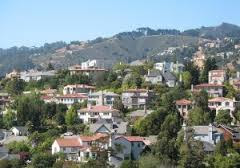Since 2012, Bay Area home prices have increased an average of 72%, based on market research conducted by Paragon Real Estate Group. It cited dwindling affordability as a symptom of an overheating market.
The median Bay Area home price hit a record $755,000 in May, the third consecutive monthly record, according to the data analytics firm CoreLogic. However, there was a slight decrease in home prices between April and May.
Median home prices rose 3.1% in Alameda County between May 2016 and May 2017, but declined 1.1% between April and May of this year, according to CoreLogic. In Contra Costa County, home prices rose 6.5% between May 2016 and May 2017 but declined 0.7% between April and May of this year.
“We started seeing the latest round of price increases beginning in 2012,” said housing policy expert Carol Galante, faculty director of the Terner Center for Housing Innovation at UC Berkeley. “It’s moderated a tad in San Francisco, which has brought on some more supply of housing; but in the East Bay prices haven’t moderated at all because there’s not much new supply of housing.”
Other areas becoming more competitive than Bay Area
It’s no secret that the Bay Area’s housing price boom and crisis in housing affordability is largely due to decades of job creation exceeding development of new housing, said Jordan Levine, senior economist at the California Association of Realtors, who sees regions centering on Austin, Denver, Portland and Seattle as becoming economically more competitive than the Bay Area.
Galante said there are concerns that the current real estate boom risks making the Bay Area’s economy unsustainable. As more people are priced out of the local housing market, they will move further and further afield, or jobs will leave the Bay Area and the region will suffer economically, she said.
There may come a day when major tech employers seeking to attract talent will say enough is enough with housing costs in the Bay Area and decide to relocate elsewhere, potentially changing the economic dynamics of the region from growth to a downward cycle, she said.
Levine agrees with that assessment: “It’s going to be a tough sell if you want companies to keep creating jobs in the Bay Area if housing remains unaffordable.”
There are examples of this happening to a small degree already. Zapier, an apps integration company headquartered in Mountain View, offered its employees up to $10,000 in relocation reimbursements if they moved out of the Bay Area.
Galante doesn’t think, however, there will be a real estate collapse like there was after the dotcom crash of the 1990s and the recession of 2008, with their massive job losses.
There has been some recent slowdown in new tech jobs, but the local tech economy is still thriving, driven by Google and Facebook, she added.
“I can’t say how this boom will end, but I don’t think it will be a total crash like 2008,” said Galante.
Real estate booms and busts are cyclical but people often have an exaggerated notion about how long each will last, according to an updated report released in June by Paragon, which tracks housing market cycles in the Bay Area. But it doesn’t work that way.
In the aftermath of a real estate “bubble popping” (or market adjustment), the recovery period typically lasts five to seven years before the next downturn. “We are currently about five years into the current recovery, which started in early 2012,” the Paragon report said.
Predicting timing of cycles extremely difficult
It is still extremely difficult to predict with any accuracy when different parts of the cycle will begin or end. Market adjustments are not always necessarily devastating crashes, but sometimes can be more like air being released from an over-inflated tire.
Typically, housing at the lowest price range in less affluent neighborhoods experiences the greatest price appreciation and biggest price declines — during booms and busts. This year the market for more moderate priced housing remains “quite hot” with prices continuing to appreciate quickly, while the prices paid for more expensive homes have plateaued, according to the Paragon data. Prices for condos have declined.
If business as usual continues, the Bay Area faces a further hollowing out of its middle-income residents, continuing increases in home prices, larger household sizes for the less wealthy, more long-distance commuters, and more residents who live on investment incomes, rather than wages, according to the Association of Bay Area Governments (ABAG).
With the population of the Bay Area projected to reach 9.5 million by 2040, new housing construction needs to return to levels of production not seen since the 1980s to support the best scenario of sustained economic growth with new job creation and affordable housing, according to the Regional Forecast for Plan Bay Area 2040, a report produced by ABAG.




No comments:
Post a Comment